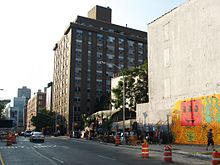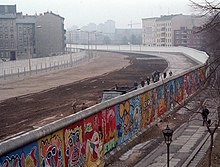Background

 Germany's Berlin Wall (shown 1986) was a target of artists during its existence (1961–1989) |
 "Independent public art" such as a balance sculpture can be installed in remote areas, and may be short-lived. |
Street art is a form of artwork that is displayed in public on surrounding buildings, on streets, trains, and on other publicly viewed surfaces. Many instances come in the form of guerrilla art, which is intended to make a personal statement about the society that the artist lives within. The work has moved from the beginnings of graffiti and vandalism to new modes where artists work to bring messages, or just beauty, to an audience.
Some artists may use "smart vandalism" as a way to raise awareness of social and political issues, whereas other artists use urban space as an opportunity to display personal artwork. Artists may also appreciate the challenges and risks that are associated with installing illicit artwork in public places. A common motive is that creating art in a format that utilizes public space allows artists who may otherwise feel disenfranchised to reach a much broader audience than other styles or galleries would allow.
Whereas traditional graffiti artists have primarily used spray paint to produce their work, "street art" can encompass other media, such as LED art, mosaic tiling, stencil art, sticker art, reverse graffiti, "Lock On" sculptures, wheatpasting, woodblocking, yarn bombing, and rock balancing. New media forms such as video projections onto large city buildings are an increasingly popular tool for street artists—and the availability of cheap hardware and software allows such artwork to become competitive with corporate advertisements. Artists are thus able to create art from their personal computers for free, which competes with companies' profits.
Originsedit
Slogans of protest and political or social commentary graffiti on walls are the precursor to modern graffiti and street art, and continue as one aspect of the genre. Street art in the form of text or simple iconic graphics of corporate icons can become well-known yet enigmatic symbols of an area or an era. Some credit the Kilroy Was Here graffiti of the World War II era as one such early example; a simple line-drawing of a long-nosed man peering from behind a ledge. Author Charles Panati indirectly touched upon the general appeal of street art in his description of the "Kilroy" graffiti as "outrageous not for what it said, but where it turned up". Much of what can now be defined as modern street art has well-documented origins dating from New York City's graffiti boom, with its infancy in the 1960s, maturation in the 1970s, and peaking with the spray-painted full-car subway train murals of the 1980s centered in the Bronx.
As the 1980s progressed, a shift occurred from text-based works of early in the decade to visually conceptual street art such as Hambleton's shadow figures. This period coincides with Keith Haring's subway advertisement subversions and Jean-Michel Basquiat's SAMO tags. What is now recognized as "street art" had yet to become a realistic career consideration, and offshoots such as stencil graffiti were in their infancy. Wheatpasted poster art used to promote bands and the clubs where they performed evolved into actual artwork or copy-art and became a common sight during the 1980s in cities worldwide.citation needed The group working collectively as AVANT was also active in New York during this period. Punk rock music's subversive ideologies were also instrumental to street art's evolution as an art form during the 1980s. Some of the anti-museum mentality can be attributed to the ideology of Marinetti who in 1909 wrote the "Manifesto of Futurism" with a quote that reads, "we will destroy all the museums." Many street artists claim we do not live in a museum so art should be in public with no tickets.
Early iconic worksedit
The northwest wall of the intersection at Houston Street and the Bowery in New York City has been a target of artists since the 1970s. The site, now sometimes referred to as the Bowery Mural, originated as a derelict wall that graffiti artists used freely. Keith Haring once commandeered the wall for his use in 1982. After Haring, a stream of well-known street artists followed, until the wall had gradually taken on prestigious status. By 2008, the wall became privately managed and made available to artists by commission or invitation only.citation needed
A series of murals by René Moncada began appearing on the streets of SoHo in the late 1970s emblazoned with the words I AM THE BEST ARTIST. René has described the murals as a thumb in the nose to the art community he felt he'd helped pioneer but by which he later felt ignored by. Recognized as an early act of "art provocation", they were a topic of conversation and debate at the time, and related legal conflicts raised discussion about intellectual property, artist's rights, and the First Amendment. The ubiquitous murals also became a popular backdrop to photographs taken by tourists and art students, and for advertising layouts and Hollywood films. IATBA murals were often defaced, only to be repainted by René.

René Moncada: I AM THE BEST ARTIST, New York (1986)

Comments
Post a Comment